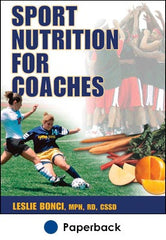Tips for eating right after exercise
This is an excerpt from Sport Nutrition for Coaches by Leslie Bonci.
Postexercise Eating
Your athletes will always have more training sessions in a week than competitions, so postexercise eating plays an essential role in helping the athlete recover quickly so that she can get out there and do it again the next day. Timing is the key factor in expediting recovery and assisting in muscle tissue repair. Athletes need to be reminded about the importance of fueling after exercise and making this a priority. Make sure that before they shower, text message, put on the i-Pod, or drive home from practice, they eat to replete! Cool-down is a perfect time to have your athletes stretch and eat something. This way, you know they’ve refueled!
Tell your athletes “within 15.” You want them to eat or drink something containing calories within 15 minutes of completing exercise to optimally replete muscle and liver glycogen stores. If they don’t, they will need up to 24 additional hours to recover, and they do not have that kind of time!
Some athletes will tell you they are too tired to eat during this period of time and are not hungry anyway; they may tell you that they will eat when they are hungry, but that is too late. Your athletes need fuel the most when they want it the least! Figure 3.1 illustrates the need to bracket athletic activity with food and fluid.
Make food and beverages readily available to athletes so that refueling is not an afterthought. Your athletes need to bring a bottle of sports drink or a water bottle containing a powdered sports beverage to practice. They should also have nonperishable food in their bag such as granola or cereal bars, a small bag of cereal, some pretzels, trail mix, or a package of peanut butter crackers. At the high school level, parents and booster clubs can supply the postgame snacks. At the university level, handing a bottle of water or sports drink and a sports bar to athletes after workouts, or having food available and visible, can be a great reminder to refuel.
There has been some recent research on the benefit of chocolate milk as a recovery beverage (Karp et al. 2006). However, milk must be stored at a temperature of 40 degrees F or colder to prevent harmful bacteria from growing in the milk. If coolers are available, consider a sports shake, chocolate milk, smoothies, or yogurt for postexercise repletion.
When your athletes exercise in cold weather, consuming warm foods after exercise can expedite blood flow to the extremities. Hot cocoa, instant soup, or instant oatmeal can provide a warming, nourishing postexercise fuel. This can be helpful for skaters and ice hockey players or during cold-weather football and soccer practice. Consider getting the high school booster clubs involved; at the collegiate level, consider working with your food service department.
As a sports dietitian, I often am asked why athletes can’t just have fruit or drink fruit juice after exercise. The carbohydrate in fruit is fructose, which takes longer to resynthesize muscle and liver glycogen than does glucose or sucrose. Your athletes can have fruit as long as they also consume another carbohydrate source to expedite muscle glycogen recovery. Orange juice and pretzels, or a banana with a granola bar, would be fine. The goal is to drink or eat at least 50 grams of carbohydrate as soon as possible after exercise. Listed in table 3.2 are 50-gram carbohydrate equivalent food choices.
For athletes who don’t want something sweet, suggest Chex mix, Goldfish crackers, or pretzels—about a cup and a half of any of these.
Should athletes consume protein with carbohydrate after exercise? Specific amino acids such as glutamine and arginine may hasten the body’s ability to resynthesize glycogen after exercise (Ivy et al. 2002; Varnier et al. 1995; Yaspelkis and Ivy 1999). In addition, protein plus carbohydrate may assist in the repair and synthesis of muscle proteins after endurance exercise (Levenhagen et al. 2002). These studies suggest a more rapid recovery from exercise with some protein, but the amount required is small, about 15 grams, and the body still needs more carbohydrate than protein. Chocolate milk, trail mix, a peanut butter sandwich, or a high-carbohydrate sports bar would all work well.
Remind your athletes that they do not have to consume a full meal in the 15 minutes after exercise. They can wait until they are hungry to eat, but the meal should still have a significant amount of carbohydrate, so a steak, salad, or chicken wings alone is not going to cut it. Breads, pasta, or rice should be part of this meal to help the athlete to recover fully. It is not necessary for the athlete to consume huge quantities, because that may lead to unwanted weight gain. The most important consideration is for your athletes to eat a little something right after each bout of exercise.
Learn more about Sport Nutrition for Coaches.
More Excerpts From Sport Nutrition for Coaches

Get the latest insights with regular newsletters, plus periodic product information and special insider offers.
JOIN NOW


